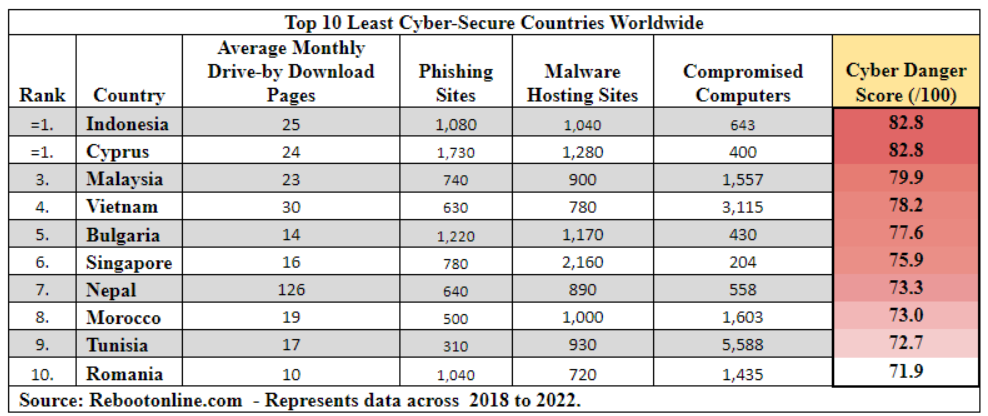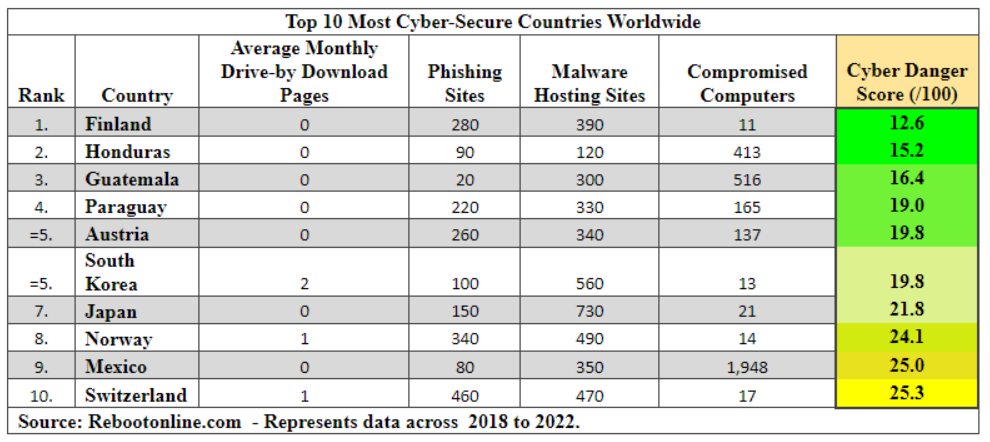The Least and Most Cyber Secure Countries
The Least and Most Cyber Secure Countries
Edited by Dr. Terry Kibiloski
Are you a digital nomad? In 2023, many people are looking to improve their work life balance, with 78% of those engaged in remote working saying their work life balance has been improved. In fact, a new trend of digital nomads has arisen where people are travelling the world whilst working remotely, enabling them to explore exciting places while building their career. However, the important question remains — which countries are safest to work from online?
With this in mind, experts at Reboot SEO Company analyzed cybersecurity statistics, including drive-by downloads, phishing sites, malware hosting sites, and compromised computers in order to create a cyber danger index score and establish which global countries are the least and most secure to work from.
Key global findings:
1. Indonesia and Cyprus are the least cyber-secure countries for working abroad
2. Finland is the most cyber-secure country worldwide
3. Five of the top 10 countries with the least secure networks are in Asia
Top 10 Least Cyber-Secure Countries Worldwide
For the full data set for all countries, variables, and infographics please click here.
Reboot SEO Company found that Indonesia and Cyprus share the crown for the least cyber-secure country in the world, with a cyber danger score of 82.8 out of 100. Surprisingly, Indonesia has already established itself as a favorite hotspot for remote workers, enticing travelers with its thriving capital of Jakarta, and popular tourist destinations in Bali. Meanwhile, Cyprus, who hosts over 3,000 phishing and malware sites combined, have only recently started to welcome remote workers to their shores.
In third position is Malaysia, where there are 1,557 compromised computers and 900 malware hosting sites which aid its overall cyber danger score of 79.9/100. South Asian country, Nepal, in seventh (73.3) has the highest drive-by downloads average of all countries analyzed, at 126 every month.
From the hustle and bustle of Marrakech to the historical medinas in Tunis, if you’re looking to explore—and work in—these North African cities, take note that Morocco (73) and Tunisia (72.7) rank eighth and ninth respectively for the least cyber-secure, with scores over 72/100. Romania, one of only two European countries in the least cyber-secure top 10, places tenth with a cyber danger score of 71.9 out of 100.
Top 10 Most Cyber-Secure Countries Worldwide
Finland takes the crown for the most cyber-secure country worldwide. Boasting a cyber danger score of just 12.6 out of 100, the country hosts less than 300 phishing sites and a total of just 11 compromised computers per 100,000 internet users. Once your remote working day is over, you’ll still have plenty of time to explore as the country is famous for its midnight summer sun.
The North American country of Honduras stands in second at 15.2/100 for cyber danger. Although able to flaunt their low statistics for drive-by downloads, malware and phishing sites, all below 150, the number of compromised computers is still relatively high at 413 per every 100,000 internet users. Guatemala (16.4), South Korea (19.8) and Japan (21.8) are among other countries that boast scores of under 25 for overall cyber danger, indicating their solid security measures for travelers and tourists alike.
The data above was commissioned by https://www.rebootonline.com
Methodology:
1.Reboot SEO Company carried out the following research to identify the most insecure countries for a workcation. This research analyses the cyber threat landscape within each country considering the prevalence of phishing and malware along with botnet networks.
2. Python data mining tools were used to extract cybersecurity statistics from over 90 Microsoft Security Intelligence reports (2017) resulting in a comprehensive dataset containing the number of phishing sites, malware hosting sites, compromised computers (part of Gama rue botnet), and average monthly drive-by download pages for over 90 countries.
3. Each statistic collected above was presented on a per 100,000 URLs basis, with the exception of compromised computers presented per 100,000 internet users.
4. An internal dataset of over 3 million restaurants and other food outlets worldwide was used to find the number of outlets providing access to free Wi-Fi per 1,000,000 inhabitants with population data acquired from the world bank.
5. Food outlet data was not included in the overall cyber danger rankings.
6. A final normalized ranking metric considering the cyber safety factors listed above was created and sorted in descending order to identify the most dangerous countries for a workcation.







